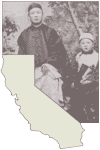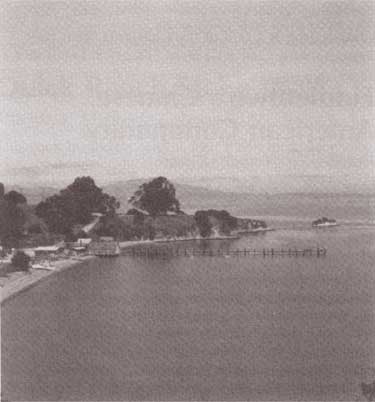![]()

Five Views: An Ethnic Historic Site Survey for California
MENU
Introduction
Early Contacts
1850s
1860s
1870s
1880s
1890s
1900s
Historic Sites
Selected References

A History of Chinese Americans in California:
HISTORIC SITES
China Camp
Point San Pedro, Marin County
China Camp contains the following historic structures.
1. The shrimp drying shed is a long, narrow, composite building with an original brick shed (c. 1880-90), which was used for drying shrimp, and a redwood frame addition off the north end (c. 1910-20). The entire building measures 10' x 34', and has a low, gabled roof with corrugated metal covering.
2. The shrimp shed was constructed with redwood planking on pine pilings over the tide line (c. 1870-90). Originally, the gabled roof, as with all the historic buildings, was covered with split redwood shingles. Now, corrugated metal covers the roof. Overall dimensions are 40' x 25'.
3. The pier, 305' long, has been lengthened since the early days of the camp. The original shed located at the shore end of the pier was about 35' wider and 75' longer than the existing wood frame shed (which has a recent corrugated metal roof).
4. The 1860s-1880 shrimp grinding shed's frame and siding remnants are attached to the existing camp store, which measures 34' x 45', and has double sash and casement windows, a pier foundation, and redwood plank frame and siding (board and batten). The power train and blower apparatus are still in the rafters of the shrimp grinding shed.
5. Of two floating houses (1900), now beached, one building, 18' x 41', has a pier foundation, board and batten siding, and a low gable hip roof. The other, 29' x 35', has a round pile foundation, lap siding, and a mansard and gable roof combination.
6. Several additional residences, an old shrimp drying platform, and the remains of three redwood sampans sunk in the mud in the adjoining cove are other evidence of Chinese American occupation in the China Camp area.
Chinese fishermen began fishing for shrimp in California probably around the mid-1860s. As the enterprise grew in the 1870s and 1880s, numerous villages or "shrimp camps" were established on the shores of both San Francisco and San Pablo bays. China Camp was one of the largest and longest-lived of these camps. The 1870 Census Records list 77 male Chinese shrimp fishermen living there in 15 dwelling units. The population grew considerably; the 1880 Census Records list 469 inhabitants, of whom 368 were directly associated with the shrimp fishery. Records also indicate that the village had three general stores, one marine supply store, and a barber shop; individuals included an instructor in Joss worship, a teacher, and a physician. Shrimp fishing was a long-established industry in China, and many immigrant Chinese arrived with knowledge of fishing and preservation techniques necessary to develop a shrimping enterprise in California.
Chinese fishermen used traditional boats, such as sampans and junks, for fishing. There even seems to have been a small Chinese American boat-building industry in California, for junks and sampans constructed of California redwood have been found.
Fishermen used traditional cone-shaped nets, which they periodically dried and mended on the bare hillsides surrounding the fishing village.
The nets were fastened to poles stuck in the ground beneath the water along the shore. Fishermen in boats emptied them and brought the shrimp in. The shrimp were then cooked and spread out under the sun to dry. When dried, their shells were cracked by a fisherman who tread on piles of them with special wooden clogs. The shrimp with cracked shells were tossed in a shrimp-winnowing machine, invented in China before the birth of Christ. This machine separated the shrimp by size, and also separated them from their shells, which were shipped back to China for fertilizer.
In the early days, there was little demand for fresh shrimp in the United States, since it was not part of the average diet. For this reason, most shrimp caught were dried and sent back to China. Later, in the 1880s and 1890s, when the demand for fresh shrimp grew in California and the shrimp industry reached its zenith in production and manpower, Chinese American shrimp fishermen came under increasing pressure from other fishing groups. Discriminatory legislation was enacted that forbade traditional Chinese fishing techniques, limited the fishing season, prohibited the export of dried shrimp, and restricted the size of the catch. As the population of China Camp dwindled, only the Quan family persisted and adapted to new regulations and changing technology. Today, Frank Quan, the descendant of an early Chinese American shrimp fisherman, continues to operate from the last pier and buildings standing at China Camp, the last operating shrimp camp in the state.
China Camp is a unit of the California State Park System and a California State Historical Landmark.

China Camp, Point San Pedro, Marin County
NEXT> Chinese American Telephone Exchange
Last Modified: Wed, Nov 17 2004 10:00:00 pm PDT
http://www.cr.nps.gov/history/online_books/5views/5views3h19.htm
![]()
 Top
Top